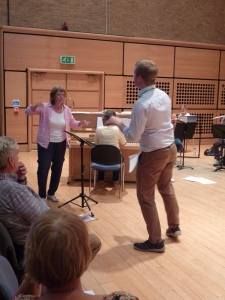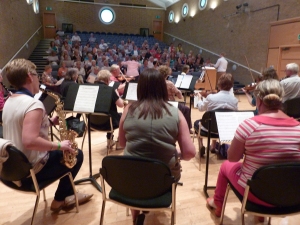The first day of the Summer School was intended for those with little experience of the technical aspects of music, but it was helpful that some with more experience had chosen to come too, they lent their neighbours a hand.
their neighbours a hand.
Through the double act of Angela and Alex, we got to grips with notation, time signatures and rhythm. Angela used various beverages to help us feel the difference in length of notes: tea – crotchet, coffee – two quavers, coca cola – four semi quavers, and beer – a minim. Someone wanted to know the drink for demi-semi-quavers. Suggestions on a postcard please.
The instrumentalists went to the recital hall to look at transposing instruments, how individual parts work and how they fit together. Angela talked about the importance of counting rests by numbering the bars on the first beat: 1 2 3 4, 2 2 3 4, etc. She explained that brass players with oodles of bars rest can “read the newspaper, drink a pint of beer and still come in on time”. That’s what the trumpeter in me likes to hear.
Alex helped the singers tackle intervals (the gap between one note and the next) and reading the dots. Oh, and not forgetting reading the rests, of course.
We were all reminded of the importance of inserting pencil marks into copies:
- to mark our particular part and aid navigation
- to highlight the dynamics and the style the conductor requests
- to make it easier to not just sing this note and that but to produce a nuanced performance that comes from the heart
As Angela said, no one can remember all those details, there is no shame in using a pencil!
After tea we tried our hand at conducting.  For this session instrumentalist played and vocalists sang – fun as well as informative. Then that was it for today. Repertoire days to come. Now where’s my music… ?
For this session instrumentalist played and vocalists sang – fun as well as informative. Then that was it for today. Repertoire days to come. Now where’s my music… ?
Helena